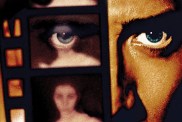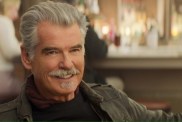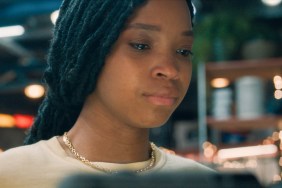The line between journalism and documentary filmmaker has been blurring with every passing year, and that’s especially true in Andrew Rossi’s documentary Page One: Inside the New York Times. As its title attests, the film goes inside the offices of The New York Times, in particular the Media Desk where journalists are trying to keep up with the changing times in technology that’s often threatening to make the newspaper obsolete.
Spending a year as a fly on the wall, Rossi captured The New York Times‘ coverage of the WikiLeaks and other important stories that forced its editors and writers to start to question how the world of journalism was changing and what the Times had to do to keep up with it, all the while facing layoffs and looming bankruptcy after an economic crash. At the center of it is a group of reporters including the veteran David Carr and the new guy Brian Stelter who is transitioning from the world of blogging to being a full-on Times reporter.
ComingSoon.net spoke to Rossi a few weeks back to find out what was involved with getting that sort of access to one of journalism’s most respected institutions.
ComingSoon.net: I know you made a couple docs about the restaurant scene in New York, and I guess David Carr was in one of them, but were you just meeting him about something else and it just transitioned into doing this? Did he give you the idea of making the movie?
Andrew Rossi: Yes, HBO had actually commissioned me to do a film about Web 2.0, something that sort of told the story of all the virtues of social media and the pioneering of new forms of information delivery so I was interviewing David, who was in my last film about the restaurant Le Cirque on that topic, talking to him about Dennis Crowley from FourSquare and Chris Dixon from Hunch. It was at the beginning of 2009, so it was right after the financial collapse in 2008, and there was a lot of speculation about the Times’ financial health, and people were sort of speculating that it could go out of business. It was an interesting intersection of this one idea that I was working on, which is, “What’s so great about the digital future” and then the notion that if there are going to be some dead bodies by the side of the road, that’s not the end of the world. At least that’s what a lot of smart people at the time were saying.
CS: But how do you sell an idea like that to everyone at the Times, because I can’t imagine anyone there would want to be part of a movie that’s basically documenting the possible death of that institution.
Rossi: My approach to filmmaking is to go in as an observer, and to practice observational documentary, which is in the tradition of cinema verite, what D.A. Pennebaker did with “The War Room” or what the Maysles Brothers did, and of course, I’m aspiring to that. It’s not always perfect or pure, especially in today’s entertainment and visual culture, but I think Bill Keller, the executive editor of the New York Times felt comfortable letting his journalists just be themselves, to the extent that I didn’t have an agenda, but the film was supposed to be an exercise in just going behind the scenes at an institution that has as its mandate original quality journalism, original boots on the ground reporting, and it could have been the Wall Street Journal, it could have been the Washington Post, it could have been the L.A. Times. For that matter, Reuters or AP or something like that, but the fact is that what he told me is, “I’m proud of my writers, and I’d like the world to see what they do.”
CS: There is a “Wizard of Oz” aspect to the Times because people who get it every day, you have this big thick newspaper, which seems to come from out of nowhere and few know what they have to do in that 24 hour period to crank that out.
Rossi: Absolutely.
CS: With that in mind, was it just a matter of going by yourself with a camera and seeing what you got? You did everything yourself, right?
Rossi: I do. I shoot in this sort of run and gun style, meaning it’s a Sony EX1 high-def camera with a shotgun mic on the top and a radio mic on the subject, so that means I don’t have anyone with lights, no sound person, no field producer. Yeah, it’s just me.

CS: What was the first day like? Was it a matter of figuring out where you could stand and how to get around without being a distraction?
Rossi: My first real day shooting in the news room was with Brian Stelter, and it was a very humdrum day. I mean, I think he was just reporting a story about Oprah announcing that she was ending her show. I would sit on the file cabinets near the cubicles, Brian has one right by him with my legs crossed with my camera and just see what happens. Nothing dramatic occurred that day but I probably got a bunch of shots of him typing and shots of his desk which ended up in a montage or something, so even in those seemingly boring moments, I’m collecting things that are important. Most important, it’s just me being next to him, basically as close as we are right now, and it’s basically like that for 14 months. That over time, you can get used to someone being next to you, and that’s what that’s about.
CS: Was there ever any sort of meeting before you started shooting so people would know who you were and why you were there?
Rossi: Well, yeah. This is after six months of meetings and instructions. From the get-go, the premise was for it to be a play within a play which means we’re following the Media Desk specifically and each story that these writers are putting in the paper about CNN partnering with Vice or the Tribune Company going bankrupt and the culture around that. Each one of these stories is a little vignette or play and then there’s this macro-play which is everyone’s personal lives and the life of the Times, sort of intertwined and will they survive? Where will they go?
CS: How did you figure out who was going to be open to being followed around?
Rossi: The first meeting I had with actual writers after talking to David (Carr) and Bruce Headlam, who is the head of the Media Desk, it was a bit conference room with about 14 journalists assembled. Actually, my daughter had pink eye so I had gotten it from her, I come in and my eyes are puffy and red and I thought that maybe if I was crying during this meeting, they’d take pity on me. (laughs) But people raised some real concerns from their point of view about confidentiality and if shooting someone background on the phone or they’re sending Emails, can what they’re doing compromise their sources, so we went through a really hardcore conversation about that. Ultimately where it lands is I’m a filmmaker but I’m also a journalist, and I sort of follow the same ethics that a print journalist does, and so we would just have to evolve over the course of many months a relationship of trust, and that’s something that’s easy to talk about but in those boring moments when you’re sitting next to somebody, you get to know them and you get to feel whether you can trust them or not. Ultimately, the New York Times didn’t have the ability to watch the film and ask for something to be removed; they had no editorial control over the film.
CS: o was there anything ever in writing beforehand to set those guidelines?
Rossi: There were several meetings and they all signed release forms basically.
CS: How do you earn the trust of someone like David Carr or even Bill Keller to get them to talk openly? Keller has a company to run and the most pressure of anyone else there, and David seems rather cynical and I imagine it would be hard to earn his trust.
Rossi: I think them being journalists and storytellers themselves, I would constantly try and keep up with all of their stories and piece together my own sense of a macro-story about what’s happening with the media landscape, so when I would go into talk to them, they could maybe relate to me as a fellow storyteller. I think that’s what’s really how you relate to someone. I was almost engaged in a form of literary journalism myself, it’s just that it was going to be in the form of pictures.
CS: Did it take a long time for them to get used to the cameras or you being there? Or was it just a couple days and they didn’t notice you at all?
Rossi: I think the “didn’t notice I was there” probably a couple months, but David did something called the Carpetbagger blog, so he’s used to being on camera so for him it wasn’t hard. Brian took maybe a couple weeks and Bill, every time I spoke to Bill on camera, it was extremely high-pressure moments. It’s during the layoffs and the buyouts when people have submitted their applications to take a buyout and then he had to fire people and during the release of the WikiLeaks documents. I guess he didn’t sort of have time to be self-conscious.

CS: That’s odd, because he seemed to be the most aware of the fact he was being interviewed and having to be careful what he says because he’s in a movie. He seems more aware of putting on the company face…
Rossi: Somebody who’s talking about wearing “bloody butcher’s smocks in the news room” which is a quote of his, my personal take from him was that he was incredibly candid, and the moments we spent with him talking to THE camera were almost like therapy sessions to him.
CS: How did you decide which of the stories to follow and include? WikiLeaks was a big one and when the iPad came out, but did you realize as these things were happening, that these were going go to play an important part in the overall movie?
Rossi: That’s absolutely right, yes. When I went into it, I didn’t know exactly what I would be following but over the course of the year, a couple of stories presented themselves and immediately I knew they were going to be sort of mini-narratives that would evolve over the course of the film. WikilLeaks is one, that was one of the first things we reported in the newsroom. Brian Stelter and Bruce and the foreign desk are trying to come to terms with, “Is WikiLeaks an advocacy group or are they a journalism group? Are they a publisher or just a source?” It’s remarkable because three months later, the Times was actually publishing directly information that had come from WikiLeaks and the initial skepticism about them sort of metastasized into something different. Some would call it a collaboration, some would call it just a straight-up source and publisher dynamic, but the principle about WikiLeaks was still there in the beginning and Bruce says it in that moment. He’s like, “This collision between new media, which doesn’t need to go through the Times or NBC, you just put it on YouTube, and old media.” The iPad, people were also talking about the tablet coming out and I knew that was something that I wanted to cover, whether that would be a new platform where print could monetize more effectively than just on a laptop. The paywall is another one, the idea of whether you should or could charge for news online.
CS: The paywall really only took effect very recently and you were shooting this last year sometime.
Rossi: I was shooting just a month ago, still.
CS: So you’ve added stuff since it was at Sundance?
Rossi: We did add some stuff.
CS: So were you generally editing as you were filming and then going back? How did you manage going through and editing all the footage you got over that extended period of time?
Rossi: So I started shooting in November 2009 and then we began editing in the summer of 2010. I was shooting on a weekly basis until about October, and then went back a little bit as needed, but the idea was always to launch the film into the cultural conversation about what is the future of journalism and wither print in a way that it could have relevance. “Don’t do it when everybody is bankrupt already and all the newspapers are gone.” In a sense, you sort of think, “Okay, I’m doing a movie about the New York Times. I really want to get it right so let’s take our time,” but on another level, the sense was that there’s an urgency to the issues that this movie is raising so this movie would be perfectly launched into the mainstream conversation at Sundance. So even when I started in 2009, I was aiming for submitting it to Sundance and hopefully getting in.
CS: What were you shooting a month ago that was added?
Rossi: We added some material from ProPublica, the investigative reporting outfit that lives online but actually publishes out to the New York Times and “60 Minutes.” We included some stuff that was previously captured at South by Southwest talking about the importance of Twitter that actually was not in the original cut.
CS: Interesting. Oftentimes we see these movies at Sundance and the paint is still wet because the filmmakers are rushing to get them done, so I’m always interested when you have an opportunity to change things. This is an ever-changing story, because a month from now you could add more stuff and it would never end in some ways. How did you know you were ready to go the first time?
Rossi: The premise of the film is a play within a play, but it’s also about going inside and seeing what these journalists are doing and letting that speak for itself and the story of David Carr reporting on the Tribune Company and the bankruptcy that Sam Zell oversaw and the allegations of sexual harassment and the way David goes about that. He spent the whole summer, several months, reporting it out, took time to write it. The Tribune Company tried to stop the story from running. That seemed such the perfect grand finale to the film that once we had that, we knew we would be okay, we knew we were ready. Then it was just a question of massaging and tweaking it and sharpening all the arguments.
CS: You were there when they were doing the first round of layoffs, which must have been fairly early in the filming, like 2009?
Rossi: That was November 2009.

CS: That must have been tough to be filming so was there ever a time when people asked you not to film or asked you to leave the room?
Rossi: So that was the only time that happened, because I was able to capture several people who took buy-outs, and then when they started to fire people, they asked me to leave for a couple of weeks.
CS: Were there any other incidents when you were in an office filming and you had to leave for something they didn’t want on film?
Rossi: No, no. There was so much tension at that time, there was a feeling of apocalypse, even throughout New York. The atmosphere in the city after the financial collapse was pretty remarkable, especially when you went inside companies that seemed to be teetering on the edge of bankruptcy, but other than that, I was really impressed by the transparency. I mean, I was not walking around with a publicist going, “Now you can film this, now you can film that.” I was every day coming in there, organizing with the writers and the editor, “What are the stories that are going to be put in the paper next week and how does it relate to this theme or that theme?” and then independently scheduling with them if they’re going to be out in the field, like when David would go out to San Francisco to cover the iPad launch or to South by Southwest in Austin to Minneapolis. I was really given free reign.
CS: As a journalist, I’m fascinated by this because I’m working online which is very different story because the way that things work online is if you don’t get the story online fast, someone else will have the story. It’s a race against time so it’s interesting to see these guys spending months working on a story. Do you think the online news world could ever get the kind of access and time the Times has to work on a story or are they always going to be different worlds?
Rossi: I do think that the future is a hybrid future. It’s about things like ProPublica where you have low overhead. They have just a website, they don’t have trucks going out there with the papers to people, etc. There’s certainly organizations that live online that have editors and writers, too, but again, this movie could have been made at the Wall Street Journal or L.A. Times or Washington Post, etc. It’s about the standards that have been evolved over many years, but also the sheer power of many different people working on the story. That team of editors sitting in that Page 1 meeting deciding what’s going to go (on the front page). Can you imagine that many people sitting twice a day deciding what’s going to go on the home page on a website?
CS: Well, we do that. I’m also curious about the amount of collaboration where you have stories by two or more writers and that seems to be a regular thing. Is that just a matter of the time frame and having to get things done by deadline or is it just a matter of writers having different expertises?
Rossi: I think that’s right. I think whenever you see a dual byline, it’s probably a function of many different things including, among others, someone’s got the relationship with a couple of sources and they can call them and then write into an article that has analysis from somebody else or it’s just sheer manpower of trying to cover it. They need multiple people coming together. I think that story that Brian and Noam Cohen wrote about WikiLeaks, about the video, that was one where they were scrambling that day to get it into print the next morning because everybody is talking about it.
CS: It’s funny but we don’t see much “scrambling” in the movie. Watching the movie, it all seems very laid back when you consider what has to happen to have a full newspaper ready to go into print at the end of the day.
Rossi: Well, that Iraq troop withdrawal story, when NBC has basically declared that the war is over before the Pentagon, when in fact, the Pentagon has not done that. We see Bruce trying to be measured about it and let Brian Williams do his broadcast and then he confers with Chuck Strom, who is sort of the person in charge that day and then they walk over to the foreign desk and they’re calling Washington and trying to see what’s happening.
CS: But they all seemed very relaxed while doing so.
Rossi: Yeah, I don’t know if it’s relaxed as much as they’re trying to be composed. I think there’s a certain old-school composure to the way that they comport themselves but I was there that day, and people were sort of freaking out. I think literally, as Ian Fischer says, “What the f*ck is going on?” They weren’t relaxed. That’s why we got an R rating for the movie because of all the curses!
CS: Where do you go from here? You have this great look into old school journalism so is there another angle that you might want to explore?
Rossi: I really don’t know. Right now I just want to get this movie out into the world, but I think I’m attracted to doing movies about places or things, institutions, that we don’t really get access to, and finding a human entry point into that. Meaning someone or a group of people who kind of make you see it in a different way you didn’t realize that maybe counters the common perception.
Page One: Inside the New York Times opens in New York exclusively at the brand-new Elinor Bunin Munroe Film Center then expands nationwide on July 1.









